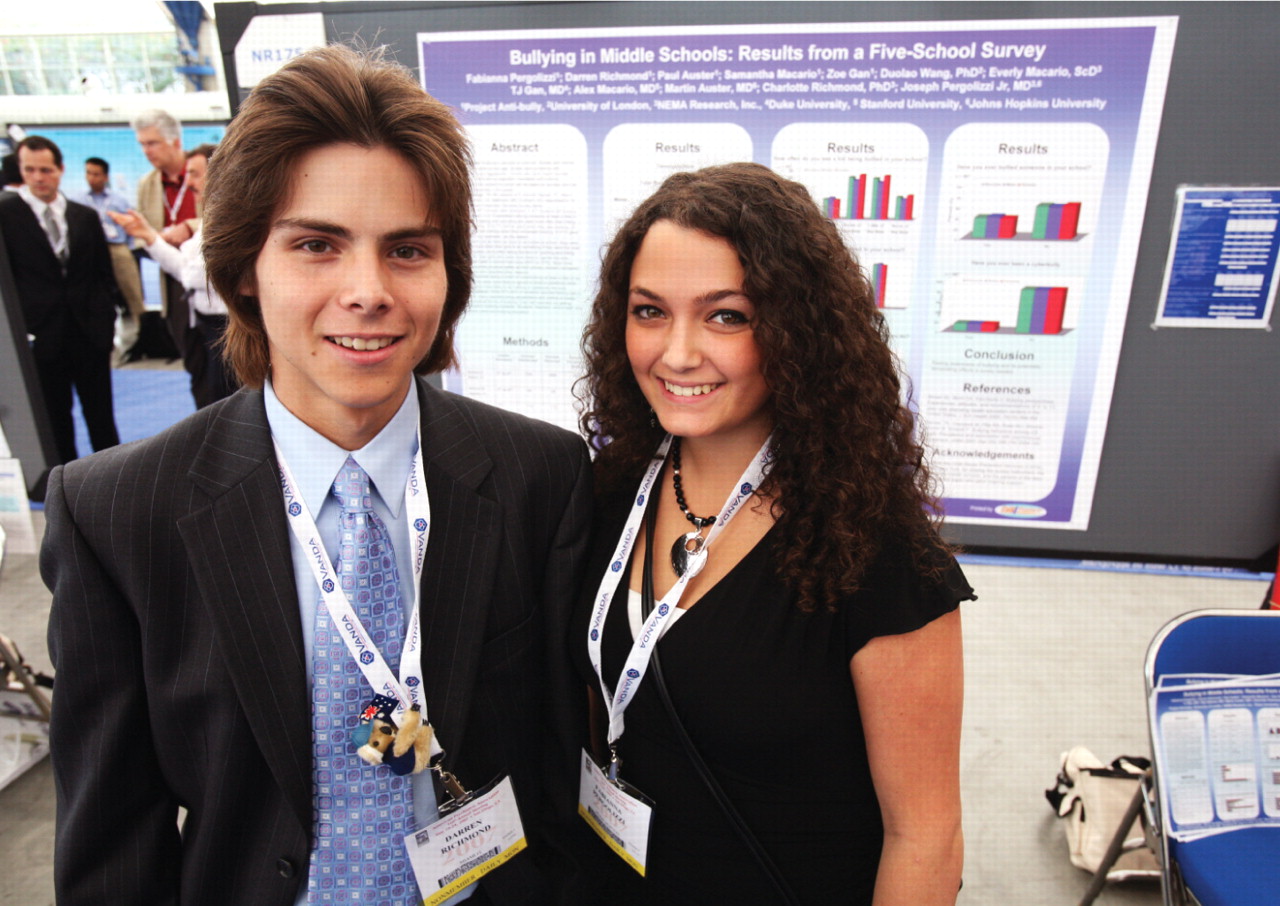When high school student Fabianna Pergolizzi became aware of the Child Abuse Prevention Services program and its survey on bullying, she realized that perhaps she was not alone in having to endure the taunts and harassment of her classmates.
To find out more about the prevalence of bullying, she rallied a group of friends from around the United States and, with permission from the Child Abuse Prevention Services program, enlisted them to distribute the survey to the middle schools in Miami, Durham, N.C., Baltimore, and Palo Alto, Calif., during the 2005-06 school year. Pergolizzi, 16, distributed the survey to students at the middle school she previously attended in Naples, Fla.
The other students involved in the project were Darren R ichmond, 16, who attends Miami Beach Senior High School; Samantha Macario, 14, who attends Gunn High School in Palo Alto; Zoe Gan, 14, who attends East Chapel Hill High School in Chapel Hill, N.C.; and Paul Auster, 18, who attends Yeshiva Lev Hatorah, a college in Israel (he was in high school in Baltimore at the time the survey took place). Together, the five students joined forces to establish Project Anti-Bully.
Of the 586 seventh and eighth graders surveyed, their responses revealed that almost half of them (45.1 percent) had been bullied. The most common response was to ignore the bully (34 percent), but reactions differed by gender—40.2 percent of girls reported ignoring the bully, while only 25.7 percent of boys did.
Boys were more likely to retaliate, with 38.8 percent of them saying they reacted by hitting or pushing the bully; 17.7 percent of girls acknowledged doing so.
Of the students surveyed, 40 percent reported having bullied other students.
Among 466 students who witnessed bullying, about 55 percent said they did nothing, and only 7 percent told an adult.
“This is a big problem,” Pergolizzi told Psychiatric News. “Some kids were afraid [to report the bully], and others said they didn't think the bullying was their business.”
In Pergolizzi's case, she had a close relationship with her parents, so did not hesitate to tell them that she'd been bullied at school. But she is worried, however, that many of her peers feel they have nowhere to turn.
Said Richmond, the co-principal investigator, “We recommend that kids tell an adult when they are being bullied so that the bullying will stop.”
Other findings showed that about a quarter of those surveyed reported being cyberbullied at least some of the time. Cyberbullying was defined in the survey as using the Internet, cell phones, or other forms of technology to harass, threaten, or embarrass someone.
The researchers also found that a higher proportion of girls reported feeling safe in school (82 percent) than did boys (67 percent).
With the mentorship of Charlotte Richmond, Ph.D., Darren's mother, and Joseph Pergolizzi Jr., M.D., Fabianna's father, the younger Richmond and Pergolizzi compiled their findings into an abstract and poster format and submitted them to APA for presentation at the 2007 annual meeting in San Diego. At the meeting, they became the youngest presenters in APA annual meeting history.
Duolao Wang, Ph.D., a statistician from the University of London, performed the data analysis for the project, and Everly Macario, Sc.D., facilitated teleconferences between the students and assisted them with editing the poster abstract and writing a manuscript for journal submission.
The students dedicated their poster to Jeffrey Johnston, a Florida middle-school student who was a victim of cyberbullying. Johnston committed suicide in June 2005.
During the process of creating the poster, HB 575, the Jeffrey Johnston Stand Up for All Students Act, also known as the “Anti-Bullying Bill” passed in the Florida House in April of this year. The bill prohibits bullying and harassment of any student or employee at a public school and requires school districts to adopt policies prohibiting bullying and harassment,
Pergolizzi said she plans to participate in the effort to pass the bill by submitting data from Project Anti-Bully to legislators.
In order to raise awareness in schools, Pergolizzi and Richmond also presented the findings to their teachers and classmates. After Richmond presented the survey results to those in his middle school, the school established “peace ambassadors”—student volunteers who welcome new students and assist classmates who are bullying victims.
The school also staged assemblies with dramatic performances in which bullying was a theme, and in their classes students were encouraged to write and create art about bullying.
At the middle school surveyed in Chapel Hill, anti-bullying posters appear in classrooms, and teachers now discuss bullying with students in health class.
Pergolizzi noted that she and her colleagues conducted the survey again during the 2006-07 school year and are analyzing the results.
“We hope that with this project, we have taken the first step toward putting an end to bullying,” Pergolizzi said. With Project Anti-Bully,“ we hope to encourage teachers and parents to talk to students about bullying and let them know they are not alone.”
More information about Project Anti-Bully is posted at<www.projectbully.com>.▪

